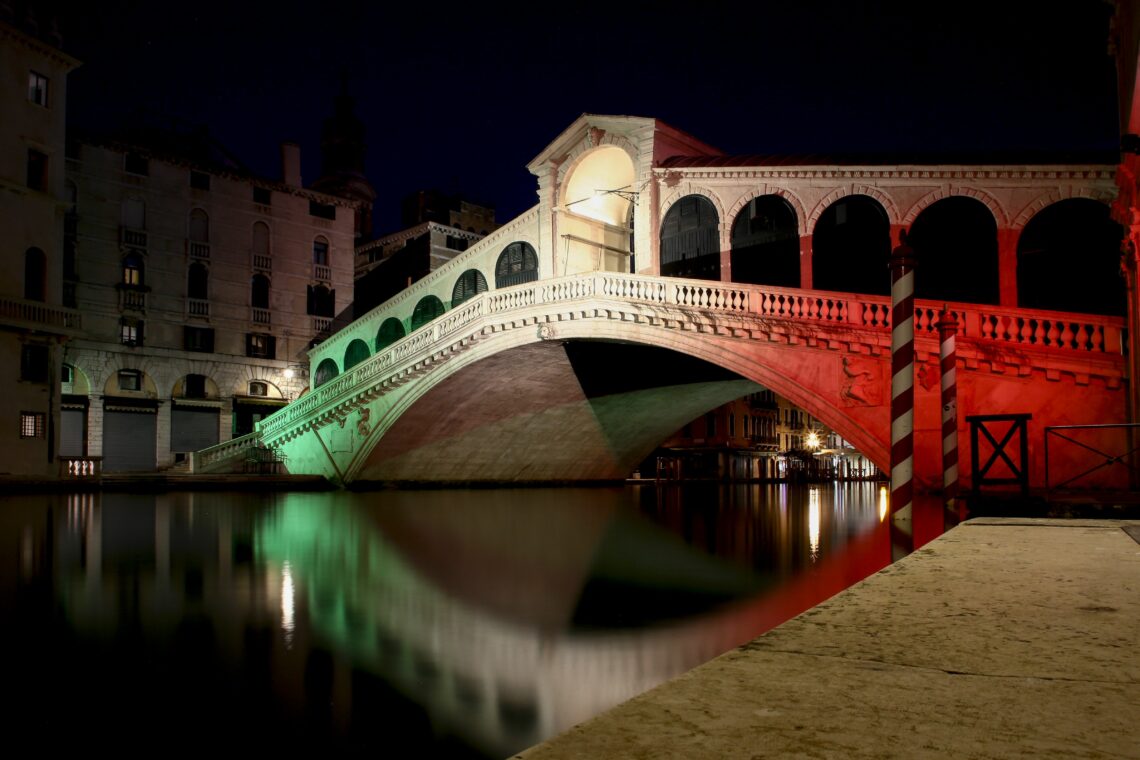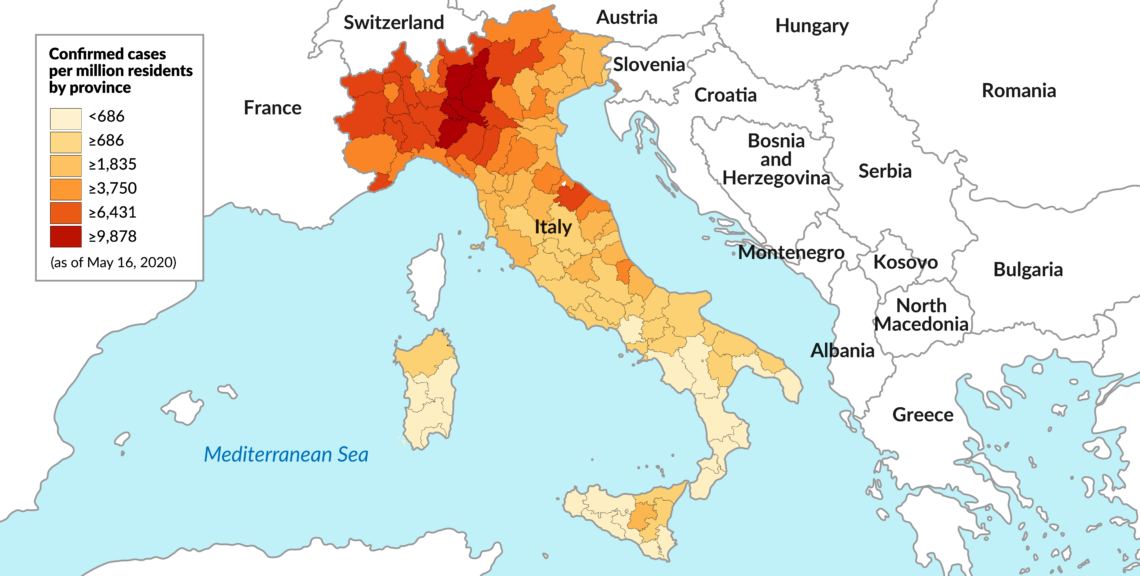Italy’s post-pandemic challenges
Despite having declared a state of emergency early, the government in Italy was late in responding to the Covid threat. This delayed reaction allowed the illness to wreak havoc in northern regions, the industrial powerhouse of the country.

In a nutshell
- The reaction of the Veneto region was exemplary
- The national government mismanaged the crisis
- The situation has highlighted institutional weaknesses
Italy was severely hit by the coronavirus. The country’s system seems modeled after the Chinese lockdown – putting health before the economy with a major crackdown on individual liberties. The strategy succeeded mainly because Italians behaved responsibly, disproving the stereotype of an unruly nation with little civic consciousness. It is still unclear whether Italy has managed to curb the disease. It is obvious that the pandemic has had one major casualty: the Italian private sector.
The country ranks third worldwide for confirmed COVID-19 cases and second for deaths. The unwelcome record is currently held by the United States.Yet in the U.S. there were about 98,000 deaths for more than 1.68 million cases. Meanwhile, Italy has almost 33,000 deaths for some 230,000 cases, and there is reason to believe that both the number of cases and casualties may have been underreported.
Facts & figures

A chronology
The Italian region of Veneto proved especially effective in containing the coronavirus epidemic, unlike other local governments. Since healthcare is a regional jurisdiction in Italy, the pandemic exacerbated tensions between the two levels of government.
Interestingly enough, the region that best handled the crisis was also the one that least followed national prescriptions.
In a recent interview, Professor Andrea Crisanti of the University of Padua said that he began gathering the chemical reagents necessary for COVID-19 testing as of January 20, when the virus began to spread from China. While such planning could have turned out to be excessive in other circumstances, it proved prescient. The second Italian infection outbreak happened in Veneto, near Padua. It was soon the object of a targeted lockdown, which limited the damage. Professor Crisanti was able to conduct extensive testing and the experience also resulted in an important study. Local authorities trusted scientific expertise and mobilized it effectively. So far there have been around 1,700 COVID-19 deaths in Veneto, with a population of 5 million people.
The rest of the country was not unaware of the risks.
Veneto, the region that best handled the crisis, was also the one that least followed national prescriptions.
Italy started checking passengers flying in from China on January 25. The first COVID-19 cases were two Chinese tourists, hospitalized in Rome on January 29. On January 30, the country closed all direct flights to and from China. People continued to enter the country from other destinations after changing flights elsewhere.
On January 31, the Italian government declared a state of emergency, which should have enabled it to make all the necessary preparations to face the looming coronavirus crisis. Yet little was done before February 21, when the first Italian case was detected.
The patient, a 38-year-old in the Lodi area (south of Milan), was an athlete who possibly exhausted his own natural defenses against the virus by running two marathons in a week. He was subsequently identified as a potential super-spreader due to his intense social activity. His pregnant wife and his father were both infected – the latter died from the illness. The man himself recovered after a bout of intense symptoms. The disease was initially identified thanks to the intuition of an anesthetist.
Ever since, the country has been in turmoil. Not surprisingly, the virus hit the north the hardest. Northern Italy is a manufacturing powerhouse, greatly integrated into international trade. Bergamo, a historic city at the heart of a dense business area, had the highest death toll, with a mortality rate of more than 50 percent in March. The other early outbreak in Padua turned out, as mentioned above, differently: perhaps out of luck, it coincided with autonomous decisions by local politicians vis-a-vis national (and WHO) guidelines.
The Italian government, led by Prime Minister Giuseppe Conte, is supported by the moderate left of the Democratic Party and the populist left of the Five Star Movement (M5S) in an alliance that was forged last year when Lega leader Matteo Salvini – hoping for an early election – dissolved a coalition between his party and the M5S. Since the eruption of the COVID-19 crisis, Mr. Conte’s popularity has risen, as Italians have rallied around the flag.
Slowing the spread of the disease took time. The lockdown was lifted on May 4. There were approximately 100,000 active infections at the time according to official numbers, but the real figures were probably higher.
At first, the lockdown was supposed to be limited to Lombardy, the site of the biggest outbreak. But in a matter of 24 hours, it was extended to the whole country. Restrictions similar to those in the Chinese province of Hubei were applied to the whole of Italy. The decision was prompted by concerns that the health system would collapse in the south of the country. While Lombardy’s healthcare can match the best in Europe, health infrastructure in southern regions is poor. It is no coincidence that some 100,000 patients from the rest of Italy travel to Lombardy every year to receive treatment.
The lockdown was severe, though essential supply chains were kept active so that stores would not run out of food. Distinguishing what is essential can be an arbitrary exercise, and Italians got through by allowing businesses to self-certify that their outputs were essential to some particular business sectors.
Constitutional rights are still severely curtailed. Italians suffered an unprecedented reduction in their liberties. Even at the height of his power, Benito Mussolini and his fascist regime never even dreamt of confining Italians in their municipalities, a feat that the coronavirus achieved. People are prohibited from traveling until June 3. Private property has been actively suspended: families cannot access their holiday homes, not even if they agree to self-quarantine as soon as they reach their destination. People cannot exercise their freedom of religion by attending religious functions. A priest in Rocca Imperiale, a town in the south of Italy, was fined for silently carrying a crucifix on the street during the lockdown.
Long-term consequences
Italy entered 2020 with an expected growth of around 0.2 points of gross domestic product (GDP). The economy is weak and the public debt was equivalent to 135 percent of GDP. That figure is expected to rise to 150 percent, or even 160 percent according to some estimates. Lombardy is home to 800,000 of the 4 million Italian companies. With Veneto, the two regions generate one quarter of the country’s GDP.
The Conte government has struggled to obtain any help from the European Union. To please euroskeptic M5S voters, the government was initially disinclined to use the Economic Stability Mechanism to finance part of the increased debt burden due to emergency spending. Instead, it bet on the European Recovery Fund, which Mr. Conte presented as a concession won from northern regions.
This macroeconomic gibberish was paired with government-guaranteed loans and golden shares. Banks and insurers, “critical infrastructure,” nanotechnology and biotech companies, artificial intelligence, robotics and cybersecurity, companies that deal with “sensitive information, including personal data,” and even firms in the food supply chain now have to ask permission if they want to sell a substantial part of their shares to foreign investors. It will not matter if new shareholders are European companies – another nail in the coffin of the European single market. If a business wants a non-EU shareholder to acquire a stake higher than 10 percent or worth more than a million euros, it must now receive government approval.
The pandemic has highlighted some of Italy’s institutional weaknesses.
This measure epitomizes the ambiguous response of the government toward the private sector. Ministers have recently expressed an interest in supporting firms by supplying them with government equity – and thus obtaining a say in their boards. The plans have not been finalized yet, but they give a sense of the circumstances which businesses are bound to face.
Such plans are not independent of Lombardy being hit the hardest. The productive heart of the system is there. It is also no coincidence that the parties of the current majority in Parliament are traditionally weaker there, where M5S never quite took off. Now comes payback.
The pandemic has highlighted some of Italy’s institutional weaknesses. Healthcare is a regional competence in Italy and accounts for the bulk of local government spending. Regions, while free to spend money, lack the power to tax. This means they remain at the mercy of the national government.The Five Star Movement used to pander to anti-vaccination voters, but then eagerly joined the idea of technocratic management by virologists during the pandemic. The prime minister and his cabinet heavily relied on the expertise of specialists. Yet they are also seizing the opportunity to ramp up government control over the economy: a paradoxical idea in a country where public spending is already equivalent to 50 percent of GDP.
A lack of regard for local governments in the north was apparent in the way the prime minister communicated during the emergency. Despite the outbreak being concentrated in Lombardy, the prime minister visited the region for the first time on April 27, staying for one night only.
Similarly, businesses that were severely hit by the COVID-19 crisis are now being aided (the Italian government offers guarantee loans to provide forbearance to companies) but they face a grim medium-term scenario. One of the first measures taken to counterbalance the effects of the crisis was to nationalize the ever-bankrupt Alitalia. The move was praised in public discourse, with pleas for more nationalizations. Generally speaking, the government, its advisors and most of its supporters tend to emphasize their skepticism toward the private sector in public discourse.
No opposition
If Italy had a parliamentary opposition worthy of this name, one could speculate on months of bitter political battles ahead. Instead, right-winger Matteo Salvini appeared confused throughout the crisis, his traditional populist rhetoric losing its appeal, according to opinion polls. He was unable to capitalize on the success of the Veneto President, Luca Zaia, who belongs to the same party. Giorgia Meloni, the leader of the Brothers of Italy party, was decidedly more vocal, but she is a traditional apostle for more nationalization and cannot easily slip into the role of spokesperson for business interests. Former Prime Minister Silvio Berlusconi defended free enterprise while staying respectful and loyal to the government though sitting on the opposition benches. He is, however, too old to have another comeback. He also spent the pandemic months on the Cote d’Azur – not the most empathetic of choices.
The government thinks that the best way of curing the country is to infect it with an older disease.
The Italian economy is going to come under severe stress in the next few months: a COVID-19 patient with preexisting conditions. Its doctor, the government, thinks that the best way of curing the country is to infect it with an older disease. Dissenting opinions are rare. For all its weaknesses, and despite its poor performance in the last few years, Italy is the second-largest manufacturing country in Europe after Germany and home to an incredibly successful entrepreneurial spirit in industries ranging from fashion to pharmaceuticals. Yet the Italian entrepreneurial class has no political party taking its side. This is not a new phenomenon. But now it could have broader consequences.






